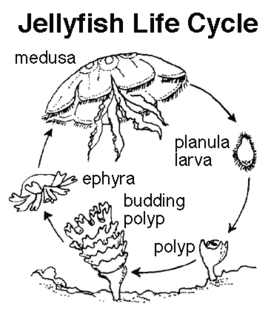Fishing First Aid : Jellyfish Stings
1. Prevention is better than cure
Please do not go swimming if you can see jellyfish in the water! If you must, then you should wear a long sleeve t-shirt and pants, or a neoprene full 3mm or 5mm diving suit is best.Be careful when investigating jellyfish that have washed ashore. Although they may be dead, they may still be capable of inflicting stings. Don't go and poke it with a stick then show your friends!
2. Keep some Vinegar in your First Aid Kit
The Jellyfish contains Stinging Balloons called Nematocyts. They fire a little torpedo containing poison into your skin when it comes into contact. The MAIN AIM OF FIRST AID IS TO PREVENT THE NEMATOCYSTS FROM FIRING. Primary first aid for any jellyfish sting should be to minimize the number of nematocysts discharging into the skin and to reduce the harmful effects of the venom. If stung by a jellyfish, the victim should carefully remove the tentacles that adhere to the skin by using sand, clothing, towels, seaweed or other available materials. As long as tentacles remain on the skin, they will continue to discharge venom.

A variety of substances have been used to reduce the effects of jellyfish stings. Meat tenderizer, sugar, vinegar, plant juices and sodium bicarbonate have all been used with varying degrees of success. Methylated spirits and other forms of alcohol formerly recommended for inhibiting stinging cells actually stimulate them and may increase pain and cause severe skin reactions. Picric acid and human urine also cause a discharge of nematocysts and should not be used. Victims of serious stings should make every effort to get out of the water as soon as possible to avoid drowning. If swelling and pain from more serious stings persists, prompt medical attention should be sought. Recovery periods can vary from several minutes to several weeks.
3. Other Interesting Tips
(Excerpt from http://www.susanscott.net/OceanWatch1999/mar22-99.html)
For box jellyfish stings, douse the area with vinegar to inactivate any stinging cells that are still on the skin. Do not use vinegar on Portuguese man-of-war stings. An Australian study reported that vinegar causes stinging cells to fire when poured on some Portuguese man-of-war tentacles. For these stings, pluck off the tentacles, then rinse the area with water, either salt or fresh. The jury is still out on how fresh water affects stings, but try it. Some sting victims feel better after taking a shower.
So far in our study, some people report good pain relief from hot packs placed on the skin. Others say that cold packs work well. Still others have experienced no relief from either hot or cold packs on their stings.
The best pain treatment for jellyfish stings is by no means a clear call.
Does urinating on jellyfish stings help?
No. At best, this common folk remedy does nothing. At worst, it can fire undischarged stinging cells and make the sting worse.
When my doctor heard about our jellyfish study he said, "Great. I hope you tell people to stop urinating on every cut and sting they get in the ocean."
Life Cycles
 The life cycle of a typical jellyfish involves an alteration of generations in which the animal passes through two different body forms. The dominant and conspicuous medusa is the familiar form, while the smaller polyp form is restricted to the larval stage. Jellyfish are either male or female and reproduce sexually. The reproductive organs (gonads) develop in the lining of the gut. During reproduction, the male releases sperm through its mouth into the water column. The sperm swims into the mouth of the female where fertilizationoccurs. Early embryonic development begins either inside the female or in brood pouches along the oral arms. Small swimming larvae (planula) leave the mouth or brood pouches and enter the water column. The larvae then seek a shaded surface and attach to the bottom, forming polyps. These polyps divide and bud into young jellyfish (ephyra). In a few weeks, an ephyra will grow into an adult medusa, thus completing the complex life cycle. Jellyfish normally live three to six months.
The life cycle of a typical jellyfish involves an alteration of generations in which the animal passes through two different body forms. The dominant and conspicuous medusa is the familiar form, while the smaller polyp form is restricted to the larval stage. Jellyfish are either male or female and reproduce sexually. The reproductive organs (gonads) develop in the lining of the gut. During reproduction, the male releases sperm through its mouth into the water column. The sperm swims into the mouth of the female where fertilizationoccurs. Early embryonic development begins either inside the female or in brood pouches along the oral arms. Small swimming larvae (planula) leave the mouth or brood pouches and enter the water column. The larvae then seek a shaded surface and attach to the bottom, forming polyps. These polyps divide and bud into young jellyfish (ephyra). In a few weeks, an ephyra will grow into an adult medusa, thus completing the complex life cycle. Jellyfish normally live three to six months. Take Home Message
1. Prevention is Better Than Cure
2. Get out of the water.
3. Pour vinegar over the area to prevent the nematocysts firing
4. Remove all tentacles using sand,cloth,seaweed etc
5. Wash the area with fresh water or salt water
6. Put Ice (In a cloth of Plastic Bag) over the sting to relieve pain
7. Seek Medical Attention
0 Comments:
Post a Comment
<< Home